How do I select a check valve for my effluent or sewage pump application?
There are 4 key factors to consider when selecting a check valve for your effluent or sewage pump application.
#1 – Desired Connection Type
There is a wide range of sewage and effluent pump check valve models available, ranging from the economy BSC-200-SB (Rubber Flapper Type 2” ABS) check valve, with flexible rubber coupling connections, to the more robust white PVC flapper type check valves such as our 17SPCV-1215,17SCC-15, & 17SCC-20 which have compression connections. 1-1/2” & 2” sizes are also available with slip connections (17SCS & 17QSCS Series) and true union slip connections (17SCTU & 17QSCTU Series). Ball check valves are available in PVC, cast iron, and stainless steel.
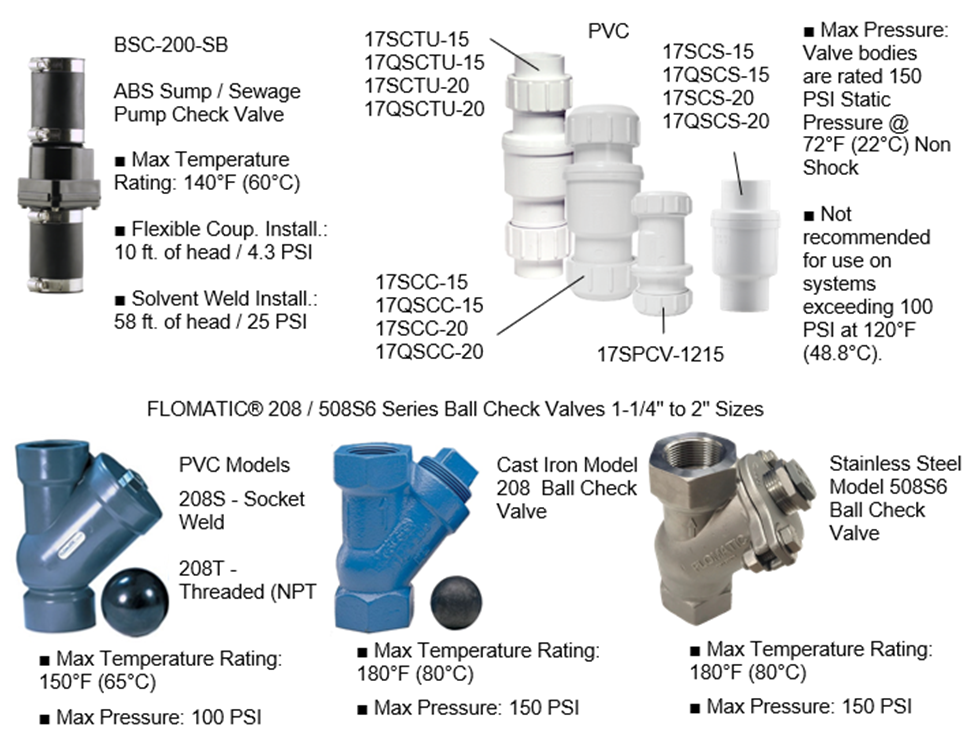
#2 – Pressure / Temperature Rating Required
The pressure and temperature rating required (see ratings above) may impact the model of valve you can select. For example, the BSC sump pump check valves are only rated to 25 PSI at 140°F (60°C) whereas the PVC valves are suitable for 150 PSI at 72° F (22°C). NOTE: End blocking of all flexible rubber couplings or compression connections is required to prevent linear pipe movement and blow-off. The cast iron model 208 and stainless-steel model 508S6 ball check valves have a higher temperature rating of 180°F (80°C).
#3 – Valve Size & Flow Velocity
Valve size is important, one must refer to the pump manufacturer's installation instructions. Typically, the discharge piping must be equal to or larger than the discharge connection on the pump. A reduction in the discharge piping could potentially void the pumps warranty. The velocity at which the water is discharged through the valve and piping also needs to be taken into consideration. Velocity is often overlooked, but under sizing will result in a flow velocity that is too high. This will result in a common cause of damage and failure of the piping and valve, hydraulic shock or water hammer. On the other hand, oversizing can result in buildup of debris. Water traveling too slowly cannot flush dirt from the valve components.
The chart below provides the minimum and maximum gallon per minute (GPM) for the piping size to maintain a desirable flow rate between 2 feet per second (fps) and 7 fps.
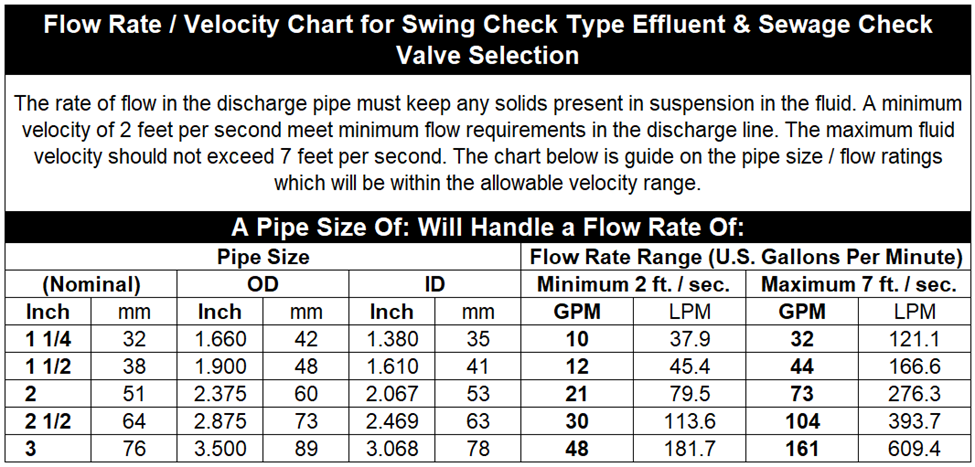
For ball check valves the recommended flow velocity is 3-5 fps.
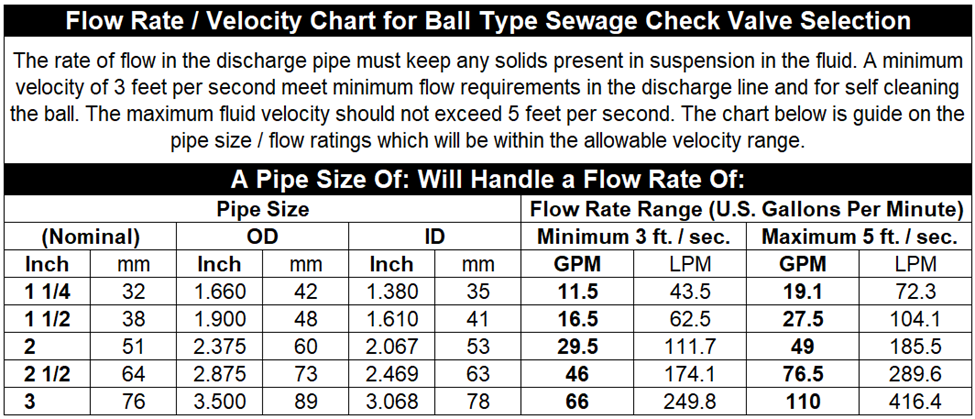
#4 – Gravity vs. Spring Assist (Quiet) Closing Design
GRAVITY CLOSING “RUBBER FLAPPER” TYPE SWING CHECK
One should consider that gravity closing type valves tend to be noisy due to the flapper slamming closed each time the flow reverses when the pump stops. The Boshart gravity closing (rubber flapper type) check valves are designed with a 15° valve seat which reduces the time and force at which the flapper contacts the valve seat. Therefore, they are “less noisy” than many sump pump check valves on the market.
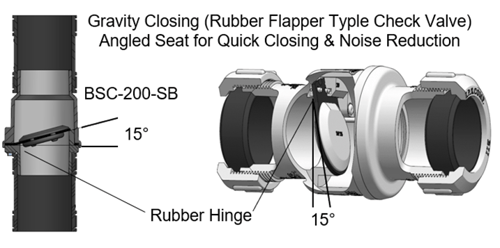
Rubber flapper valves in which the gasket seal doubles as the flexible hinge for the flapper are best suited for smaller, low HP pumps with low GPM ratings. For example, a pump discharging 21 GPM @ 2 fps asserts much less strain on the hinge than a high HP sump pump discharging 73 GPM at 7 fps in which case the fluid asserts a great deal of force on a rubber flapper. For high capacity pumps the selection of a stainless hinge pin type valve is a better choice.
GRAVITY CLOSING “BALL” TYPE CHECK
A ball check valve is a simple and reliable valve. The only moving part to block the reverse flow is a spherical ball. The full-ported valve seat is uniquely designed allowing the ball to seat leak-tight without getting wedged into the valve seat.
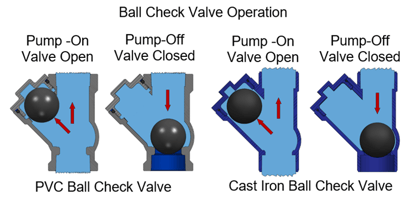
Ball check valves are designed especially for use with sewage pumps and applications involving viscous liquids or slurries. The principle of the ball check valve is very simple. The ball has sufficient weight to seat tightly even in high viscous liquid, but to open freely so that the head loss is minimal. Ball check valves can be installed horizontally or vertically. The preferred installation of a ball check is in the vertical position. This will ensure that gravity will seat the ball properly each time. However, if the ball check valve is to be used in a horizontal installation, it is important that the static head is at least 20 feet of water (nine pounds per square inch). The recommended flow velocity range is 3-5 fps.
Ball check valves are typically preferred for use in pumping stations because they self-clean as the ball rotates during operation and are virtually maintenance-free. If a ball check makes noise, it is typically due to insufficient pump capacity or water hammer issues.
A vacuum relief feature, “AUTO-VAC®, is available to reduce water hammer and noise in pipelines.
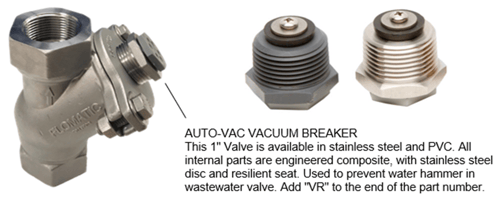
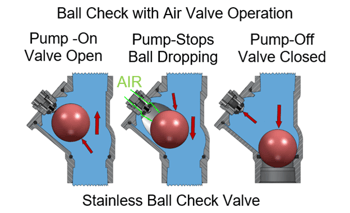
SPRING ASSISTED CLOSING “MECHANICAL HINGE” TYPE SWING CHECK
The selection of a spring assist Q series, QUIET sump pump check valve is highly recommended. They do cost a little more, however they are worth every penny. A silent swing check valve is manufactured with a stainless steel mechanical hinge pin. This hinge system is much more robust and will have a longer life expectancy. The spring closes the flapper as the pump stops eliminating all flow reversal and water hammer, and therefore their closing is silent. The reduction in wear and tear on the valve and piping will extend the life expectancy of the system. You cannot go wrong selecting a valve with a mechanical hinge system. they will perform well on all applications regardless of whether the pumps horsepower (HP) or capacity (GPM) is low or high.
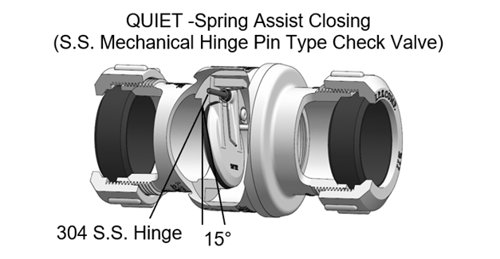
INSTALLATION: Swing type check valves used in sewage applications, where solids are being pumped, are to be installed in either a 45° degree or horizontal orientation to ensure that the solids do not settle back down on top of the flapper preventing the valve from opening when the pump starts. In addition, the valve MUST be installed with the hinge point in the top dead center position! Always refer to the sewage pump manufacturer's installation instructions. Improper installation of check valves or discharge piping could void the pump warranty!
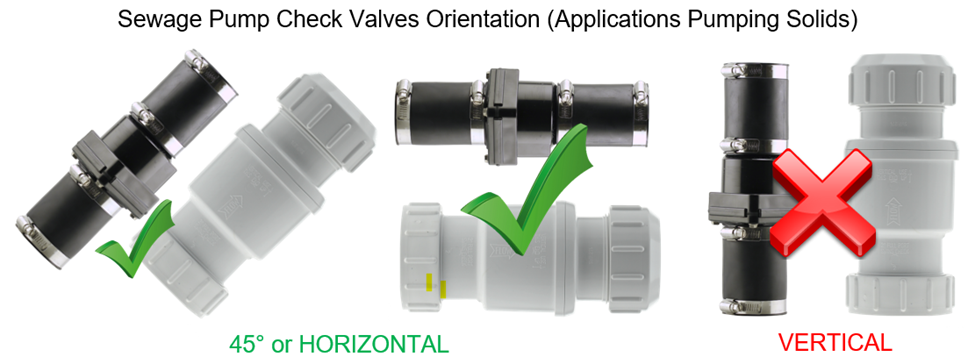
IMPORTANT: The installer must always make sure the check valve installation complies with all applicable plumbing and building codes.
